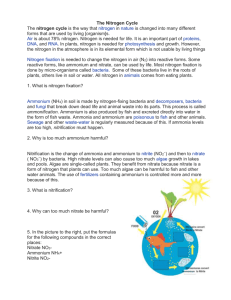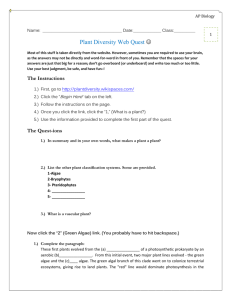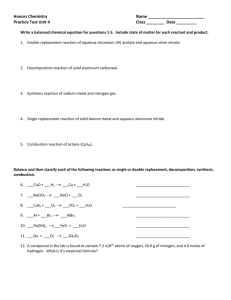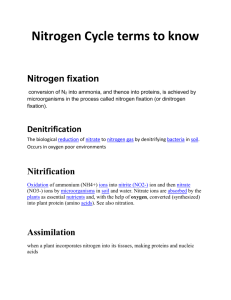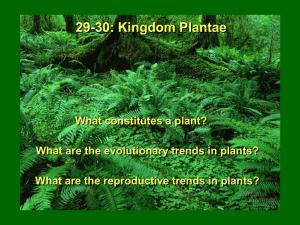File
advertisement
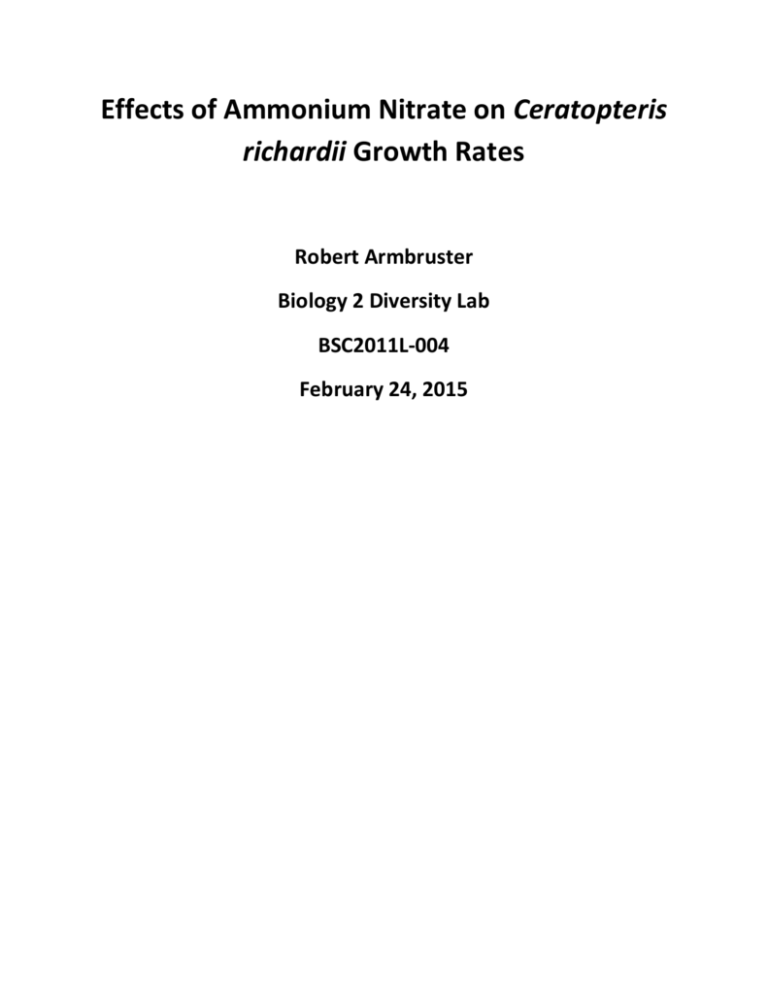
Effects of Ammonium Nitrate on Ceratopteris richardii Growth Rates Robert Armbruster Biology 2 Diversity Lab BSC2011L-004 February 24, 2015 Abstract Nitrogen has long been thought, and known, to be an enhancer of various plant species growth rates. Excess nitrogen in soil or water, allows for many plants to flourish, as well as some that are harmful, such is the case when algal blooms occur. It is believed that an Ammonium Nitrate solution, applied to Ceratopteris richardii fern spores will lead to increased growth rates. Two petri dishes, one containing a one percent Ammonium Nitrate solution, the other acting as a control, were prepared and left to grow under greenhouse lights. After five weeks of growth, the fern spore counts were collected and statistical analysis run on them. Based on the results, the hypothesis is rejected as the experimental group was found to have a lower growth rate than the control, with a mean value of 50.395 compared to the control’s 67.2666. Based on this, it could be determined that Nitrogen is not a limiting growth agent for Ceratopteris richardii, possibly acting as an inhibiting agent in this case. There is also the possibility that there was human error involved. Future research is necessary to see if these results are conclusive or an anomaly. Introduction The effects of fertilizer have been well documented for many decades on different plant species. Fertilizer and nutrient supplements allow the treated plants to grow faster or produce more depending on the plant itself. Nitrogen is known to be an effective fertilizing agent for many plant species. Nitrogen is often a limiting agent in plant growth. Plants take in nitrogen from the soil, usually with the help of rhibozomes within their root system, which is then transported into the body of the plant for chemical reactions (Melan and Whittier, 1990). If there is not enough nitrogen present, plants cannot grow properly or will be stunted, hence the use of nitrogen fertilizers on nitrogen deficient soils. Some fertilizers are better than others however (Hickok and Warne, 2009). The purpose of this study is to determine the effectiveness of Ammonium Nitrate on fern growth, specifically Ceratopteris ferns. It is believed that the Ceratopteris fern spores treated with Ammonium Nitrate will grow at a faster rate than those ferns of the control group. Methods Two petri dishes, containing an auger solution, were obtained, with one plate having been treated with a 1% Ammonium nitrate solution. The Ammonium Nitrate petri dish was labeled NH4NO3 and the other dish was labeled control. A Bunsen burner was obtained and lit in the workspace, following aseptic technique, to reduce contamination. Three drops of a Ceratopteris fern spore culture were obtained using an eye dropper. These three drops were placed gently in the center of the petri dish labeled control. A bent paper clip was passed through the tip of the Bunsen burner flame slowly three times in order to remove contamination. The clip was then used to gently spread the fern spores across the surface of the auger, being careful not to penetrate the auger layer itself. Once complete, the control dish was capped and set aside. Three more drops of the fern spore culture were placed in the center of the dish treated with ammonium nitrate. The paper clip was passed through the Bunsen burner flame three more times to sterilize it again. The clip was then used to gently spread out the spores across the top of the ammonium nitrate auger, just as was done to the control dish. When finished, the ammonium nitrate dish was also capped. Both petri dishes were then stored in the back of the lab room in a tray underneath a series of plant lights. The fern spores were left under the lights for five weeks to germinate and grow. At the end of the five weeks, the two dishes were removed from the plant lights and were placed individually under a dissecting microscope. The total number of fern spores was tallied for each petri dish and recorded in the lab manual. The data gathered from the entire class was collected and compiled by a class TA. The total data was then used to analyze the success of the experiment. Statistical analysis was performed on the collected class data. Variance was calculated for both the control and treated fern spores and an F-test was performed using those variances. The F-test value obtained was compared with a given F-test table of values. Based on the comparison of values, either a Student’s t-test or a Welch’s approximation was conducted on the gathered data. Results The results of this experiment were somewhat surprising. In each group, the control group, at the end of the experiment, contained more germinated spores than the NH4NO3 group. The final data for this experiment can be seen below, in (Table 1). Table 1: Final Average Spore Count of NH4NO3 experiment Group Control NH4NO3 1 56.43 41.64 2 67.89 52.46 3 76.65 58.23 4 59.92 51.5 5 62 49.33 6 80.71 49.21 Statistical analysis was conducted using the data in (Table 1). Variance values were calculated using the following formula: s^2= (∑(x^2)-(((∑x)^2)/n))/(n-1) The variance for the control group was 93.6607 while the variance for the experimental group was 29.2122. Calculating for the F-test, using the following formula: F= s^2(larger)/s^2(smaller) It is found that the F-test value is 3.2062. The F-crit value is 5.0503. Therefore, F-calc < F-crit and we can accept the null hypothesis, meaning that the data has homogenous variance. A Student’s t-test was then performed on the data using the Student’s t-test equation, giving a t-calc value of 3.7282. Compared to the t-crit value, a result is given of 3.7282 > 2.015048 or t-calc > t-crit, meaning the null hypothesis is rejected. Based on this data, fern spores treated with NH4NO3 do not grow as well as untreated fern spores, as can be seen in (Figure 1). It is shown that the mean value of the experimental data is less than that of the control data. Mean Values of Treatment Data 80 M e a n % s p o r e s g e r m i n a t e d 70 60 50 40 Control 30 Experimental 20 10 0 Treatment Treatment Type Figure 1: Mean values of germinated spores. Vertical lines indicate the standard error of the mean for each treatment. Discussion Based on the data collected from this experiment, and the statistical analysis performed on that data, the results are as such: treating fern spores with Ammonium Nitrate reduces the growth rate of the spores. The statistics show that the data is significant when based on the Student’s t-test. The mean value of the experimental group of spores was 50.395, significantly less than that of the control group, 67.2666, as can be seen in (Figure 1). After analyzing the data collected, the hypothesis stating that an Ammonium Nitrate solution would increase the growth rate of Ceratopteris fern spores is rejected. The spores actually grew at a slower rate than the control group. This could be for a number of reasons. The primary reason, most likely, is that perhaps Nitrogen is not a limiting nutrient in the growth of Ceratopteris ferns. Unlike in the growth of Bassica napus, the oilseed rape, where Ammonium Nitrate applied during growth of the plant led to better yield (White et al., 2015), it seems that Ceratopteris does not require Nitrogen in high amounts in order to grow. In fact, in this experiment, excess nitrogen slowed down the ferns’ growth. This result seems to go against both (Melan and Whittier, 1990) and (Haas and Scheuerlein, 1991). Both of these previous experiments showed that increased nitrogen levels on their species of plants resulted in increased growth rates during germination of the gametophyte spores. This could be looked at further, the differences between plant species germination when treated with Ammonium Nitrate. Comparing the growth rates between different common, commercial plant species, certain crops or decorative plants, for example, could be an interesting topic of study. While the results of this experiment were interesting, there could have been errors or limitations that caused the results that were received. First, there could have been contamination on either the control or experimental group, or both. While all steps were taken to sterilizing the work environment, using aseptic technique, it is still possible that contaminants ended up in the petri dishes of the experiment, resulting in skewed fern growth data. Second, contamination could have entered the petri dishes during the first and second week after the initial experiment was performed, when the initial data count was being conducted. During a period of 5 minutes or so, the lids of the petri dishes were removed, so as to allow easier viewing and counting of the spores, underneath a dissecting microscope. It is possible that contaminants entered the petri dishes at these times, which would skew the final results. In addition to the above potential errors, there could have been errors involving the human element. When applying the spores to the petri dishes at the beginning of the experiment, it is possible that the nitrogen solution was not spread evenly across the agar jelly, resulting in uneven spore growth. Also, human bias could have come into play when counting the spores. As only one person counted the spores for each test, it is possible that not all of the spore were counted, due to the observer thinking they were not germinated, or spores could have been counted multiple times, on accident. There were also certain limitations involved in this experiment. First, the experiment was conducted using a limited sample. If more fern spores had been available, more extensive testing, or at least more trials, could have been run, which might have given different, or more accurate data. Secondly, the nitrogen solution provided was in limited supply. It is possible that with more solution available, more could have been added to the petri dishes and possibly affected the experiment. References Haas, Christian J., and Robert Scheuerlein. "Nitrate Effect on Phytochrome-Mediated Germination in FernSpores: Investigations on the Mechanism of Nitrate Action." Journal of Plant Physiology 138.3 (1991): 350-57. ScienceDirect. Web. 23 Feb. 2015. Hickok, Leslie G., and Warne, Thomas R. C-Fern Web Manual. N.p.: U of Tennessee Research Foundation, 2009. Print. Melan, M.A., and Whittier, D.P. “Effects of Inorganic Nitrogen Sources on Spore Germination and Gametophyte Growth in Botrychium dissectum.” Plant, Cell and Environment 13 (1990): 477-482. White, C. A., S. E. Roques, and P. M. Berry. "Effects of Foliar-applied Nitrogen Fertilizer on Oilseed Rape (Brassica Napus)." Journal of Agricultural Science 153.1 (2015): 42-55. Web of Science. Web. 30 Mar. 2015.


